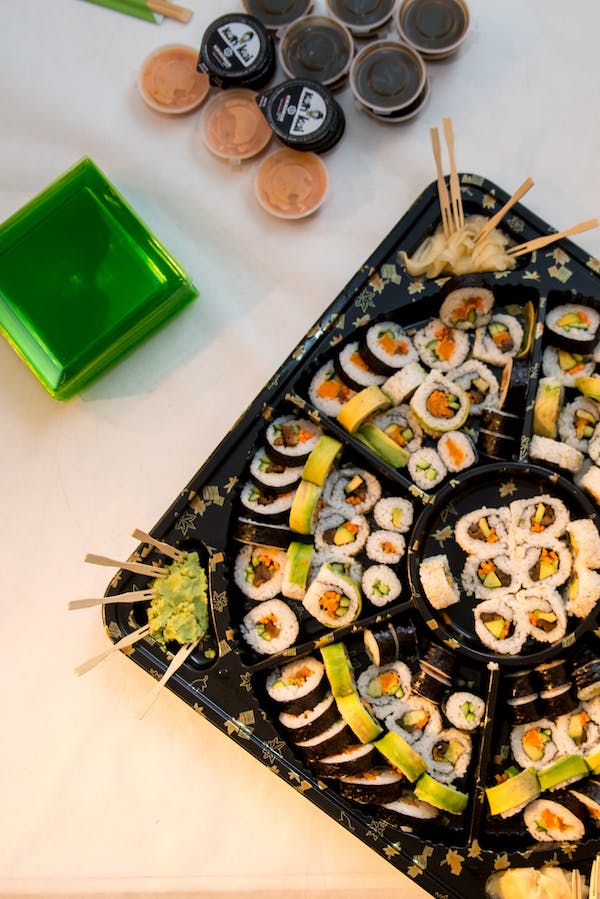One of the most popular dishes in Japan is sushi, seasoned short-grain rice complemented with a mix of seafood and vegetables or herbs. Sushi first originated during the 4th century in ancient China, where they laid salted fish in cooked rice that ended up as preserved fish and fermented rice, which then spread to Japan in the 9th century. In Japanese, the term “sushi” means “sour” or “sour-tasting.”
The first sushi created was called nare-zushi, which translates to “aged-sushi.” Some of the most traditional sushi in Japan comes in different varieties, such as cut sushi rolls (maki rolls) or hand rolls (temaki). The most notable difference between the two is that the former is cut into bite-sized pieces, while the latter is kept in a log or cone shape meant to be munched on. You may have already eaten these types of sushi, especially if you ate at some sushi restaurants before.
To further fathom the difference between the two, here is a more detailed description of each:
Cut Sushi Rolls or Maki
Maki rolls are one of the most well-known types of sushi. Perhaps, the most popular variants of these rolls are California and spicy tuna rolls, as both are staples in numerous Japanese restaurants. Cut rolls are known in many names: makizushi (maki), meaning “rolled sushi,” norimaki, meaning “nori roll,” and makimono, meaning “variety of rolls.”
A maki is made using a bamboo mat or a makisu and layering roasted seaweed or nori with seasoned sushi rice. Then, fresh seafood and/or vegetables are placed on top. The makisu is then used to roll the nori and stuffing into a log; cut into bite-sized pieces afterward.
Makizushi rolls have a cylindrical shape and can come in two types, depending on how much stuffing they each have:
- hosomaki rolls: are thin (roughly 1 inch thick) and only have one component
- futomaki rolls: are thicker (around two or more inches) and contains two or more ingredients
Japanese restaurants often have a variety of maki rolls available, which are usually split into two sections: classic (regular) and specialty. The latter typically caters to the more Western style of sushi that has a lot more sauces and toppings, western ingredients, and cooked fillings.
However, some sushi restaurants don’t serve sauced-up specialty rolls and only focus on giving the traditional sushi experience. These restaurants prefer to concentrate on the flavor of the seasoned rice and fresh fish, and the maki rolls they do serve are more simple, such as cucumber or spicy tuna rolls. These restaurants will usually put notices at the front, explicitly stating they don’t serve specialty rolls or tempura.
The following are examples of classic rolls:
- California roll
- spicy tuna roll
- rainbow roll (a California roll with various types of fish and avocado on top)
- salmon and avocado roll
- cucumber roll
Some specialty rolls served in restaurants usually contain more toppings and fillings, such as eel sauce and dynamite. Some examples are:
- TJ roll: shrimp and vegetable roll topped with jalapeno, garlic chips, and tomato
- Philadelphia roll: salmon, cream cheese, and avocado
- Sake bomb: cucumber, shrimp, and spicy tuna roll with salmon and avocado on top and drizzled with hot sauce and imari
Hand Rolls or Temaki
Another type of sushi, which is different from makizushi for being left whole and not cut into bite-sized pieces, is the hand rolls, also known as temaki.
Essentially, temaki is a layer of seasoned sushi rice overlayed with different fish, vegetables, and greens wrapped in a sheet of nori. Hand rolls are shaped like a long cylinder or a cone and are typically around four inches long.
Temaki is made using only your hands (unlike the makizushi that’s made with a mat), and you eat this sushi, still with your hands, as its long shape makes it challenging to eat using chopsticks. You would also want to consume hand rolls immediately after assembling to savor the crips, roasted nori.
This type of sushi roll is not as popular as makizushi, but some restaurants serve them, turning them into a growing trend.
Temaki is incredibly easy to make and super fast to prepare, making it one of the best food to eat if you’re in a hurry. Making homemade hand rolls or temaki can also be an excellent DIY dinner for you, your family, and your friends. All you need to do is prepare your sushi rice, mince or slice fresh sushi-grade fish, and layer in any ingredient such as scallions or cucumbers.
You can make temaki with different varieties and fillings. Some of the most popular ones are:
- spicy tuna with sprouts of radish
- sed snapper with shiso leaves
- salmon avocado with scallion strips and sesame seeds
- blue crab infused with a bit of Kewpie Japanese mayonnaise
- baked salmon skin with cucumber slices and radish sprouts
